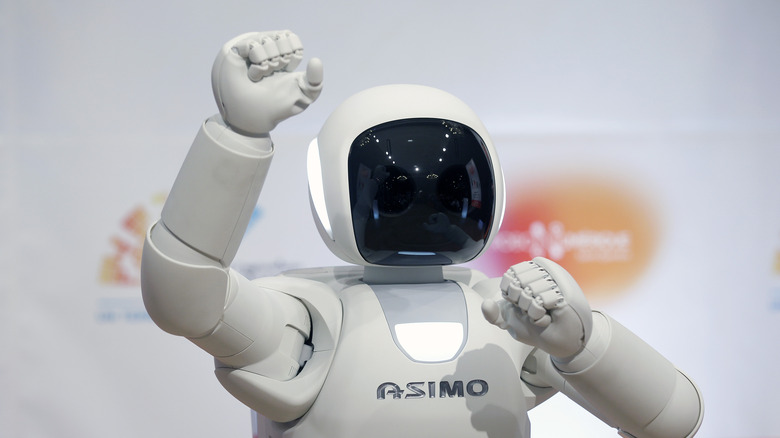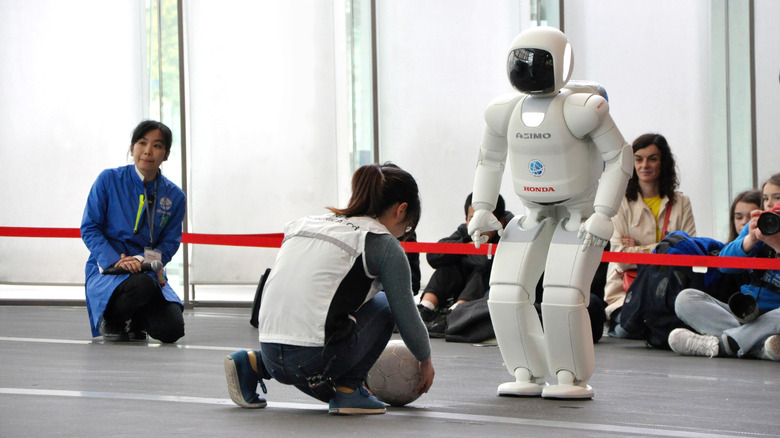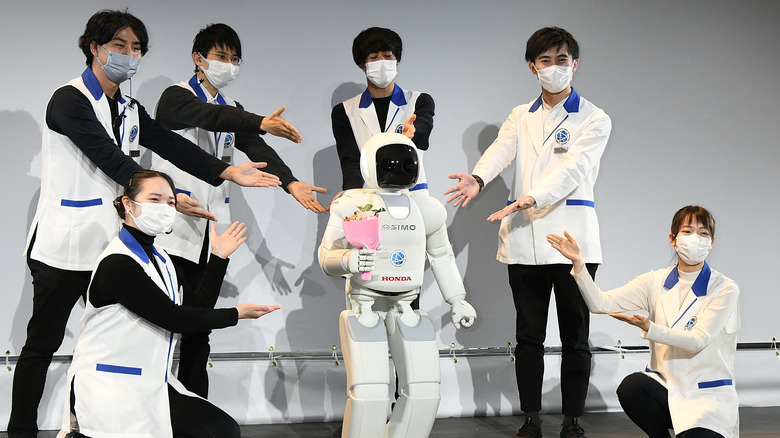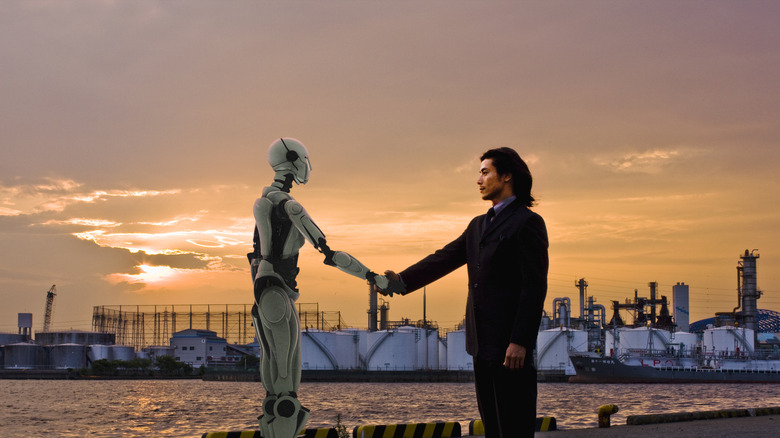Whatever Happened To Honda's Robot Asimo?
In 2000, Honda launched ASIMO (Advanced Step in Innovative MObility), an advanced humanoid robot that sparked the imaginations of innovators and technology enthusiasts worldwide. Named after the famed science-fiction writer Isaac Asimov, Asimo was the first robot designed to be able to interact in a human-like manner. At the time, Asimo was the first robot to walk on two legs and climb ramps using battery power. It also used sensors and AI to avoid bumping into things, identify moving objects, recognize people's faces, and even learn sign language.
With a goal of becoming a robot that could make lives easier and more pleasant, Asimo's rounded edges and awkward demeanor (videos of it tripping during a demonstration are still online) became an endearing vision for a humanoid robot-enabled future. However, nearly two decades after its launch, Honda quietly retired Asimo. In a 2018 report, Nikkei reported that Honda stopped the development of the iconic Asimo robot.
Here's a quick look at Asimo's impact on pop culture, why its journey ended, and what it means for the future of humanoid robots.
Asimo's Impact in Pop Culture
The idea of humanoid robots has been around for centuries. In pop culture, the fascination with humanoid robots exists in movies, TV series, and comic books. In fact, when the robotics division of Honda was first started in the 1980s, an article in Japan Times claimed that the engineers were told to make the comic hero "Astro Boy" come to life.
Since its launch, Asimo has been a poster child for what a peaceful co-existence with robot technology could mean for humanity. For years, Asimo graced trade shows and performed on stage for audiences. When Asimo learned how to run, many spectators celebrated as if it were their own child. During its years of operation, Asimo was introduced to international leaders, scientists, and heads of state. In 2014, The Wall Street Journal reported Asimo even played soccer with President Barrack Obama.
Around this time, Disney's Big Hero 6 included a white robot sidekick called Baymax, which was partly inspired by Asimo. According to Gizmodo, the filmmakers visited Asimo in Honda's Tokyo showroom and resolved to use Asimo as a baseline for the character's pleasant personality in the well-loved movie.
Why Asimo's Journey Ended
While Asimo was an entertaining way to get people comfortable with the idea of robots, it couldn't properly fulfill the requirements for commercial use. Unfortunately, this was reason enough for Honda to shut down the project permanently. However, this doesn't mean that Asimo and the technology will just disappear.
On its website, Honda shared three key functions that it learned from Asimo: moving around while sharing the same space with people, performing tasks using hands, and interacting with people. Unlike industrial robots, which require razor-sharp precision to perform minute tasks, Asimo's lofty goals of giving human-like experiences required a sort of adaptability that its technology just wasn't ready for.
To perform services that require care, such as handling orders in a restaurant or assisting in health services, requires nuance and balanced touches. Honda reiterates that to be able to create robots that can operate around people, it has to prioritize safety and the ability to absorb impact in the event of a collision.
In addition, the auto manufacturer mentioned the need to establish laws that protect people in a world where robots and humans co-exist.
The Future of Humanoid Robotics
While Asimo is no longer being actively developed, its journey to inspire scientists and ordinary people about the future of humanoid robots is far from over. In recent times, Honda claims that Asimo's technology has been used to develop sensors for self-driving cars, medical devices, etc. In addition, many other robot manufacturers have been making big strides to take off where Asimo fell short.
From jellyfish-inspired robots that are being developed to help clean ocean beds to a host of other robotic animals, newer and more complex robots are released every year. While some are inspiring stories, there have been cases of them turning slightly evil. Although there have been reports of delivery robots running amok, there's still a lot of potential for creating commercially viable robot technology that can help people live their lives more meaningfully, even if they can't shake your hand.
These days, some developers are still gunning to make the most human-like robots out there, like Hanson Robotic's Sophia. However, if there's any lesson that Asimo's short journey taught us, sometimes, you don't need to always look human to improve human lives.



